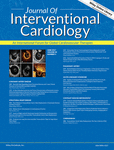Comparison of the nephrotoxic effects of iodixanol versus iohexol in patients with chronic heart failure undergoing coronary angiography or angioplasty
Abstract
Objectives
The aim of this clinical trial is to compare iodixanol with iohexol for the incidence of contrast-induced nephropathy in patients with chronic heart failure with reduced ejection fraction who are currently undergoing coronary angiography or angioplasty.
Methods
The clinical trial included 220 consecutive patients with chronic heart failure with reduced ejection fraction undergoing coronary angiography or angioplasty. Study participants were administered either iodixanol (n = 110) or iohexol (n = 110). The primary study endpoint was the incidence of contrast-induced nephropathy within 72 h after the procedure. The secondary endpoints were to determine the peak increase in serum creatinine levels and Cystatin C, and the peak decrease in estimated glomerular filtration rate at 72 h post-contrast medium.
Results
Baseline demographic and clinical characteristics of the patients were similar between the two groups. Our study showed that the overall incidence of contrast induced nephropathy in patients with chronic heart failure was 20.9%. The incidence of contrast induced nephropathy was significantly lower in iodixanol group than in iohexol group (29.1% vs 12.7%, P = 0.041). The peak increase in serum creatinine levels and the peak decrease in estimated glomerular filtration rate after the procedure were statistically significant between the two groups. Moreover, there was statistically significance in the peak increase of Cystatin C levels after the procedure.
Conclusions
In patients with chronic heart failure with reduced ejection fraction who are currently undergoing coronary angiography with or without percutaneous coronary intervention, the iso-osmolar contrast iodixanol was associated with a lower incidence of contrast induced nephropathy than low-osmolar contrast iohexol.




